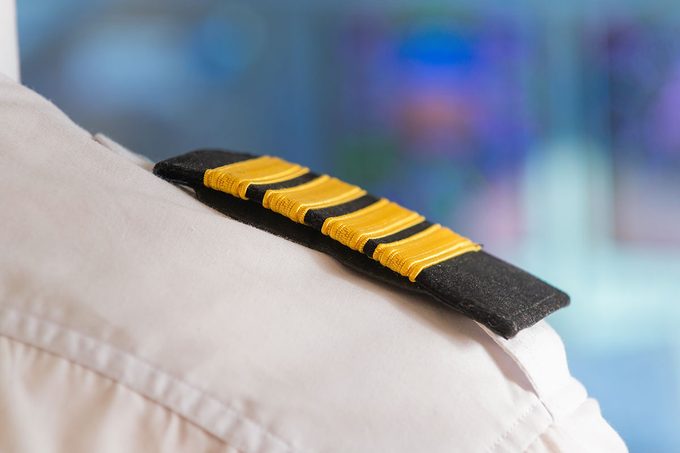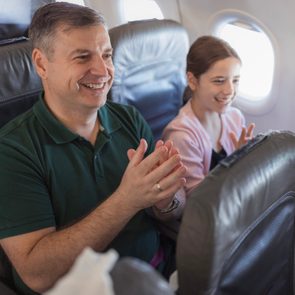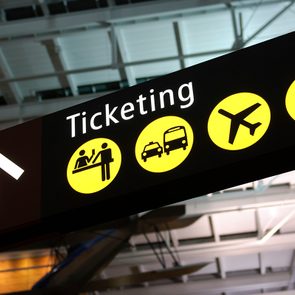The world of aviation is full of hidden symbolism, and pilots' uniforms are no exception. Here's what those stripes are all about.

This Is What the Stripes on a Pilot’s Uniform Mean

Airline pilots may all look similar in their crisp white uniforms and winged pins, but take a closer look at a pilot’s shoulders and sometimes their sleeve cuffs. Yep, there it is: those subtle stripes adorning the uniform. You may just assume they’re a fashion statement or simply chalk them up to “tradition,” but they actually hold a significant meaning that’s related to how many stripes there are. That’s right—that number varies from pilot to pilot, and it’s not random.
Intrigued? We certainly were, so we spoke to a former pilot to decode this bit of airplane trivia. Read on to understand exactly what those stripes mean, what they’re technically called and how pilots earn them.
Get Reader’s Digest’s Read Up newsletter for more travel, humor, tech, cleaning and fun facts all week long.
What are those stripes on a pilot’s uniform actually called?
Shoulder straps containing stripes on a pilot’s uniform are called epaulets (also sometimes written as epaulettes), a term derived from the word épaule, which means “shoulder” in French.
While most passengers may not notice them, they matter deeply to pilots. “There is an absolute sense of achievement with the epaulets,” says Dan Bubb, PhD, a former first officer at Air Vegas Airlines and the author of Landing in Las Vegas: Commercial Aviation and the Making of a Tourist City. That’s because they convey a pilot’s authority, responsibility and years of professional training.
What do the stripes signify, exactly?

“The number of stripes matches your job title,” Bubb says. “I remember when I received my first-officer epaulets. All of the years I spent building flight hours and training to achieve my dream of becoming an airline pilot finally paid off. I felt like I was on top of the world.”
Here’s a handy guide to pilot stripes (four in total) and who wears them:
- One stripe: Worn by a cadet or trainee pilot who is still building hours under supervision and completing flight school.
- Two stripes: Worn by a flight engineer or second officer, often third in command on multi-crew aircraft. They may assist with pre- and post-flight inspections and monitor aircraft systems during the flight.
- Three stripes: Worn by a first officer, or co-pilot, who shares flying duties with the captain, including pre-flight checks, takeoff, landing and in-flight operations.
- Four stripes: Worn by the captain, also known as the pilot-in-command, who holds full authority and responsibility for the safety of the aircraft, passengers, crew and overall flight operation.
How do pilots earn their stripes?
“When a pilot is hired to fly for an airline, they must first go through ground school and then pass a flight or simulator test,” Bubb explains. “After they pass those tests, they will be issued epaulets according to their starting position.”
Climbing the ranks in aviation requires accumulating flight hours and passing command assessments, or performance reviews. If a first officer, who already has a minimum of 1,500 hours of flying time, wants to become a captain? Bubb says they must have received “consistently positive reviews” from captains to move up the chain of command.
Then comes the irreplaceable on-the-job training, which helps make safety, situational awareness, proficiency and professionalism second nature. “On average, it takes two to three years for a first officer to upgrade to captain,” Bubb says. “By that time, first officers have considerably built their total hours in addition to experience flying a specific type of airplane.”
After passing a flight or simulator check, newly minted captains typically fly alongside other captains or highly experienced first officers for an additional 6 to 12 months to demonstrate proficiency while transporting passengers. “After that,” Bubb says, “they are fully fledged captains.” With their four stripes.
Are stripe designations consistent across airlines?
More or less. The stripe system is generally consistent around the world, according to Bubb, and it’s guided by standards set by the Federal Aviation Administration (FAA) and the International Civil Aviation Organization (ICAO).
Where did epaulets come from?
According to the U.S. Navy, epaulets may have originated in the late 17th century as practical cloth straps that were used to secure belts or shoulder sashes in place, or possibly even as a form of protection against shoulder injuries during combat. Over the next century, they evolved into clear symbols denoting military rank.
When you hear the word epaulet, you might think of French military general and statesman Napoleon Bonaparte, who helped usher in the height of epaulet fashion. During his campaigns across Europe, Napoleon and the French Imperial Army wore lavish epaulets that signified an officer’s branch of service and rank through the type of metal used and the extravagance of the design. On Napoleon, thick gold fringes cascaded from ornate shoulder pieces—elite accessories that became unmistakable symbols of prestige and power, even to this day.
How did their use evolve in the U.S. military?
America’s Continental Army initially looked to their British Army counterparts—who began using epaulets to denote officer rank in 1768—for inspiration. They adopted similarly showy and expensive designs, sometimes compared to “fancy hairbrushes.” As the Navy website notes: “In our Army, officers started wearing gold or silver epaulettes in 1780 during the Revolutionary War and continued to do so until 1872, mostly on their dress uniforms.”
Over the next century, epaulets transitioned from impractical forms to more functional, streamlined alternatives, such as embroidered shoulder straps and metal insignia. They also made the leap into military aviation during World War I, followed by commercial aviation. “In the early 1930s, pilots [on commercial aircraft] began wearing uniforms,” Bubb explains. “This was a requisite dress code implemented by the airlines because the pilots were transporting passengers and needed to look professional.” Pan Am, then a leader in commercial aviation, modeled its pilot uniforms after naval officers’ attire—and the traditions spread to other airlines and stuck.
And these days? “Some airlines have modernized the uniform by changing colors or the thickness of the stripes,” Bubb says, “but uniforms for the most part have stayed the same.”
RELATED:
- Here’s Why So Many Flight Attendants Wear Red Lipstick
- Here’s Why Flight Attendants Might Sit on Their Hands During Takeoff and Landing
- Here’s Why Flight Attendants Pay Attention to Your Shoes
About the expert
|
Why trust us
Reader’s Digest has published hundreds of travel stories that help readers explore the world safely, easily and affordably. We regularly cover topics such as the best places to visit (and the best times to visit them), tips and tricks to zoom through airport security, flight-attendant secrets, hotel-room hacks and more. We’re committed to producing high-quality content by writers with expertise and experience in their field in consultation with relevant, qualified experts. We rely on reputable primary sources, including government and professional organizations and academic institutions as well as our writers’ personal experiences where appropriate. We verify all facts and data, back them with credible sourcing and revisit them over time to ensure they remain accurate and up to date. Read more about our team, our contributors and our editorial policies.
Sources:
- Dan Bubb, PhD, former first officer at Air Vegas Airlines, associate professor at the University of Nevada and author of Landing in Las Vegas: Commercial Aviation and the Making of a Tourist City; email interview, June 2025
- Naval History and Heritage Command: “Epaulettes and Shoulder Straps”
- Simple Flying: “How & Why Did Pan Am’s Sea Captain Pilot Uniforms Become the Standard in Commercial Aviation?”
- Insight Aviation: “From Co-Pilot to Captain”
- Smithsonian: “George Washington’s Epaulettes”



